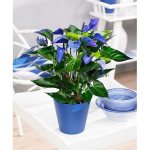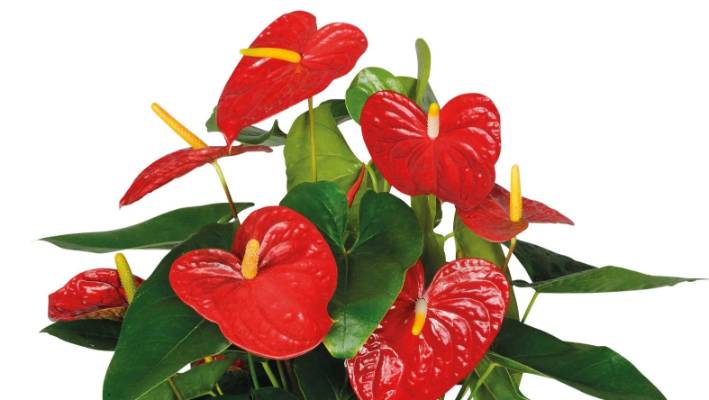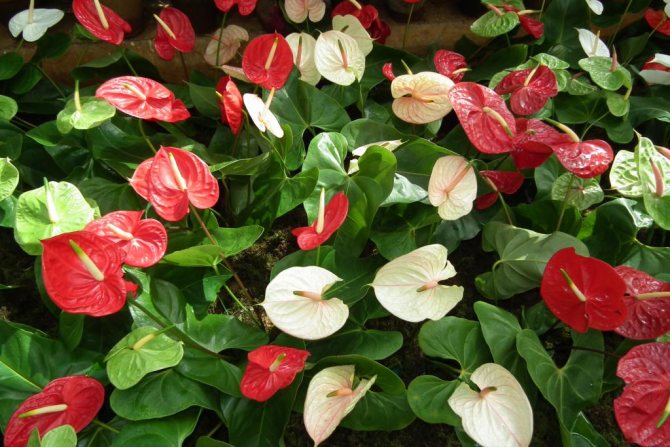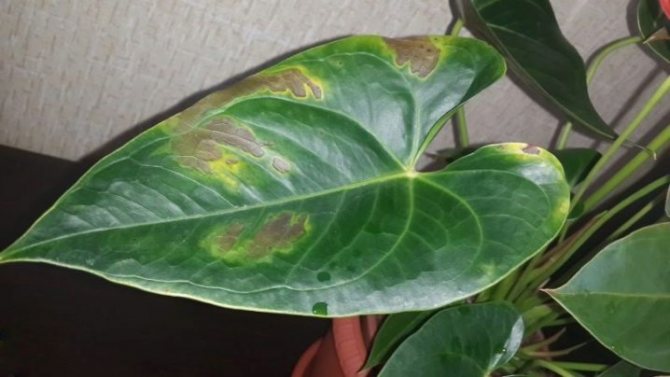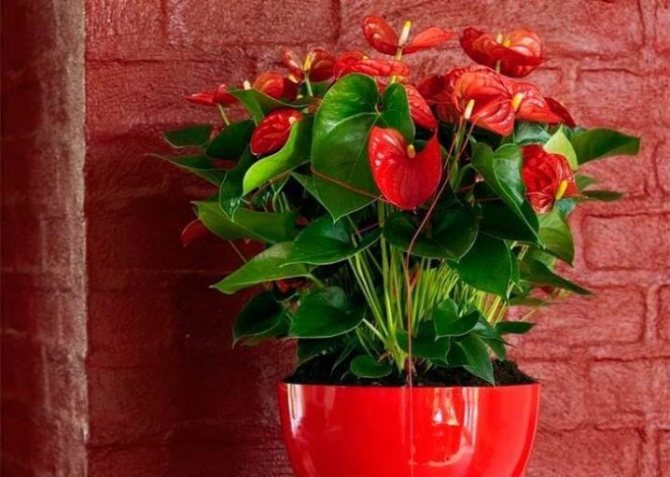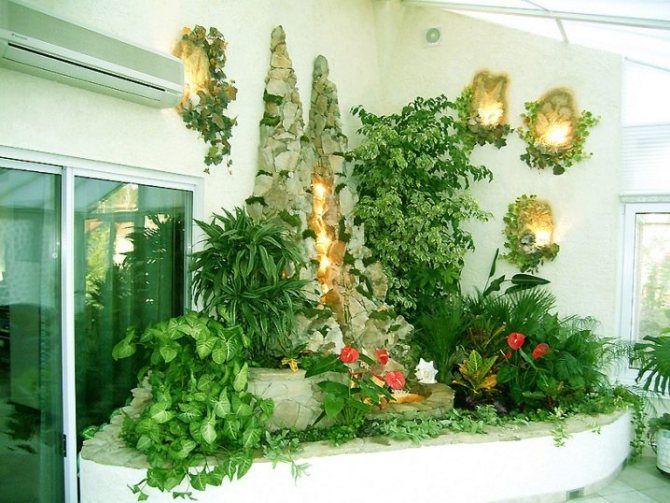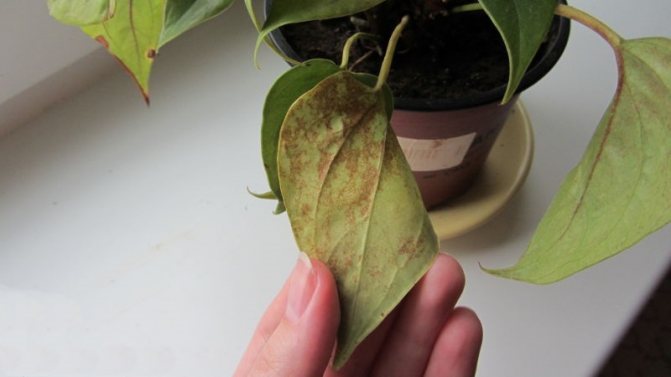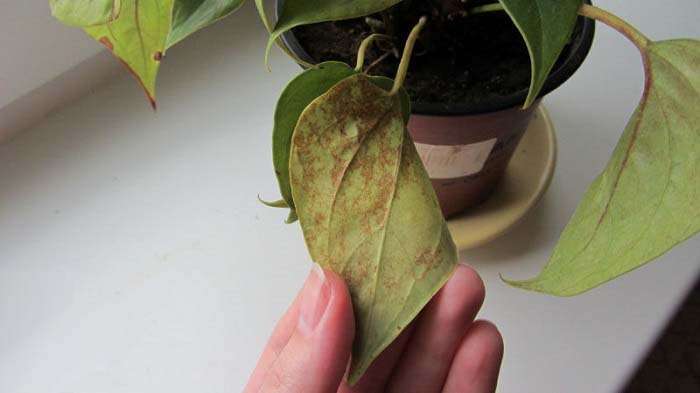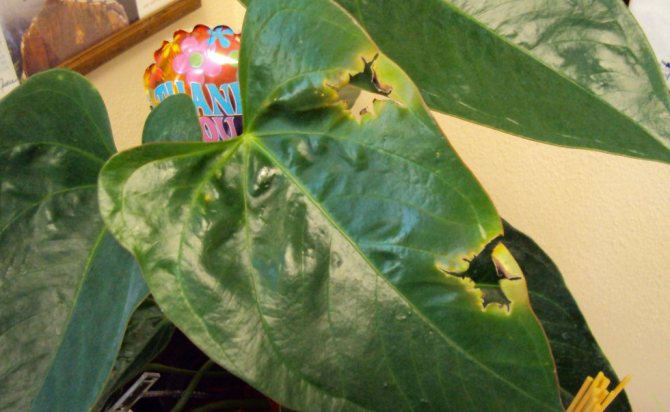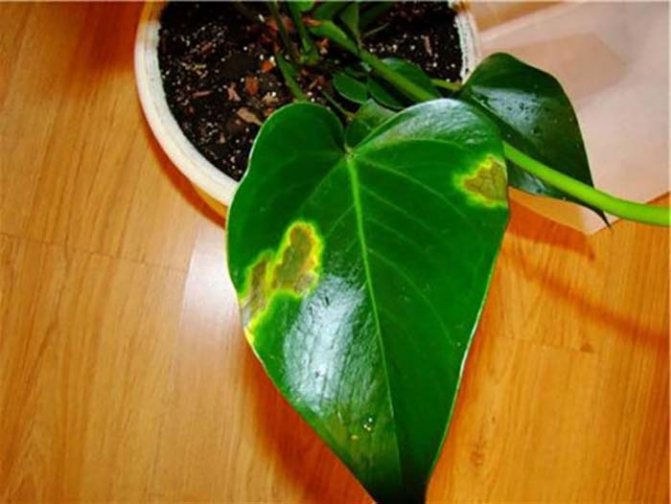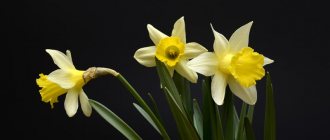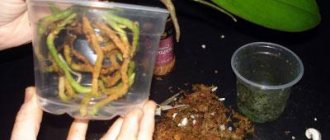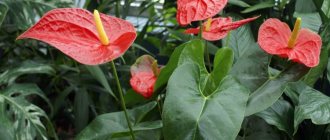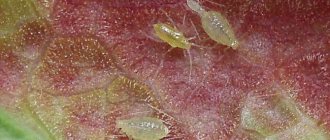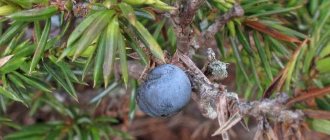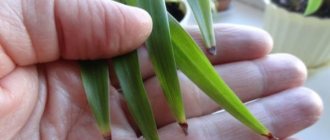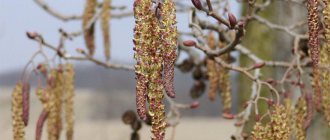Anthurium is the flower of kings, which pleases with a long noble flowering, regardless of the season. Red, white, pink, purple plates appear on a mature bush and last for several months without the characteristic signs of aging. But only a healthy plant can please with abundant and rich flowering. That is why every florist should know not only how anthurium grows, but also study leaf diseases (see the photo below) and how to treat the bush so as not to lose the plant at all.
Brown spots on anthurium leaves: why they appear and how to get rid of
A plant called anthurium is known to almost all flower growers. Due to the beautiful combination of green leaves and red flowers of the original shape, it is often called the flamingo flower. This is one of my favorite “pets” and does not require special care and attention. But recently I started to notice that brown spots started to appear on the usually smooth and bright leaves of the plant.
I didn't want to lose such beauty, and I immediately began to look for the cause of the problem, which I managed quickly enough. If you had to face a similar situation, I will tell you how to save a flower from death and return it to its original appearance.
Chlorosis of anthurium
It is a non-communicable disease. Sometimes under bright light, yellow spots appear on the leaves of the plant, but the veins remain green. This is due to a lack of iron and magnesium. Chlorosis usually becomes noticeable with irregular feeding or its absence and only in bright light. To fight the disease, it is necessary to regularly feed the plant with fertilizers containing magnesium and iron.

Dry air
For normal growth, anthurium requires not only proper lighting, but also sufficient air humidity - at least 70-85%. If the air is too dry, the leaves will begin to turn yellow, dry and fall off, and new leaves cannot unfold normally, remain twisted and deformed.
Most often, a similar phenomenon is observed at the beginning of the heating season, when the air humidity drops sharply, and the plant can no longer receive moisture from the soil. To correct the situation, you can:
- use household humidifiers;
- put containers with water next to the flower;
- pour drainage into the pan of the pot, fill it with water and place the plant so that its roots do not touch the water.
In addition, it is necessary to water the anthurium a little more often, but not overfilling it.
The soil should be moist, but not swampy - excessive moisture damages the flower no less than a lack of watering. Water the plant so that moisture does not get on the leaves. Even small drops of water act as lenses - the sun's rays are focused in them, which causes tissue burns.
Reasons for which leaves dry and become stained
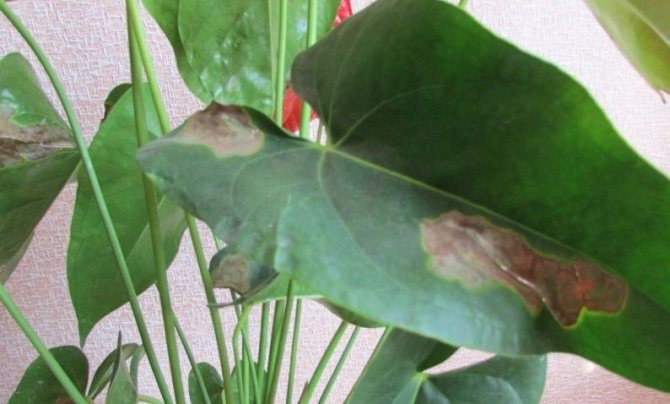

If mistakes are made with watering, the fertilizing schedule is violated, the room has excessively dry air or improper lighting of the plant, the leaves of the anthurium gradually dry out.
Often, the development and beauty of the leaves of a plant is affected by a sharp drop in temperature, as well as growing a flower in a cold room.
If the rules for growing a plant are violated, it begins to hurt and disappears.Therefore, it is important to know the main reasons due to which leaves of anthurium dry or become covered with spots of different colors.
Incorrect fertilization
The lack of nutrients is indicated by slow growth of the plant, small young leaves. The leaves turn brown due to a lack of nitrogen, phosphorus or potassium, as well as calcium or magnesium.
It is recommended to feed the plant with liquid ready-made products. The affected flower is fed every week. As soon as the plant comes into force, feeding is reduced to once every 14 days.
With an excess of fertilizers, anthurium leaf plates can also change their color. To save the plant, transplant it into new soil, after flushing the roots.
Causes of leaf blackening
The following reasons lead to blackening of leaves in anthurium:
- the influence of direct sunlight;
- drafts;
- wrong air temperature;
- the presence of calcium salts in the substrate.
If the leaves of the anthurium turn black due to a draft, the pot must be moved to another cozy place.
When blackening the leaf plates due to sunlight, make a shaded place for the flower. It is important to provide the flowerpot with diffused sunlight or partial shade.
Pest attack
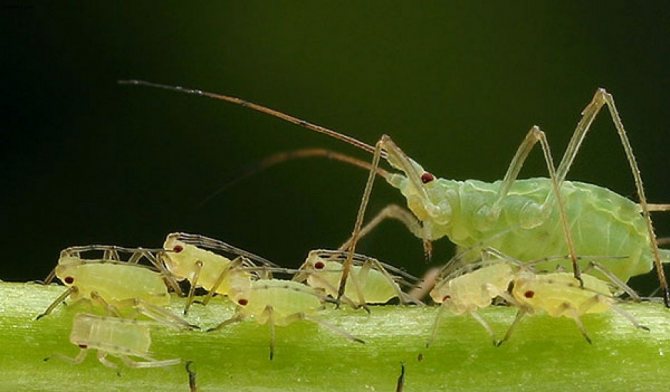

If the leaves are covered with yellow spots and begin to curl up, it means that aphids attacked the plant. To save the plant, treat it with special products or tobacco tincture.
If the shoots are covered with cracks and the leaves are spots, the flower is struck by a mealybug. To destroy it, karbofos is used.
Dark spots on the leaves of anthurium appear due to the attack of the scale insect. Pests must be removed, and the plants must be treated with laundry soap mixed with kerosene.
The appearance of brown spots
Anthurium produces brown spots on the leaves due to the following reasons:
- improper feeding. It is recommended to fertilize with fertilizers with balanced substances;
- if the room temperature is too low, the leaves become covered with small brown dots.
If brown spots were noticed, the stem may have been damaged by a mealy worm, which can be destroyed with special chemicals.
The appearance of yellow spots
Anthurium leaves turn yellow due to lack of light in winter. Watering the plant with water with chlorine and heavy metal oxides also leads to this phenomenon. To avoid the yellowness of the leaf plates, it is recommended to water the flower with rain, melt or settled water.
If water accumulates in the pan, the roots of the flower rot and the leaves turn yellow. It is important to moisten the soil moderately, and drain excess liquid from the pan.
A small potted plant can also produce yellow leaves. In this case, it must be transplanted into a large container.
Causes of leaf drying


Anthurium leaves dry due to dry air, insufficient watering, diseases or aphids.
The frequency of watering depends on the season. The soil should dry out by a third of the pot between waterings. To increase the humidity of the air, spray the leaves with water daily.
In the case when the leaves dry at the edges, and then begin to dry completely, it means that the plant has suffered from anthracnose. Treat with a systemic fungicide to eradicate the disease.
Age changes
Most often, leaf plates turn yellow in anthurium due to aging. Age-related changes affect more the foliage, which is closer to the ground.
Yellowness spreads over the entire area of the leaf, due to which it loses its elasticity and juiciness, acquires a brown color. After a while, it disappears on its own, if it is not removed earlier.
If the anthurium is well and properly looked after, the loss of old leaves does not harm the plant, since young healthy leaves begin to grow at the top of the stem.
Since yellowing leaves do not benefit the plant, but only take away strength, it is best to remove them on time. If you remove old leaves, the flower will develop better and become more attractive.
To cut off the leaves that have become obsolete, it is recommended to treat scissors or a knife with alcohol so as not to infect the stem. Sprinkle the cut areas on the trunk with fine charcoal. In the case when the leaf turns yellow, but has not lost its juiciness, it is impossible to cut it off by hand so as not to injure the stem, so use only a sharp tool for this purpose - a knife.
Fungal diseases
Fungal infestation is one of the most common causes of yellowing of anthurium leaves. Spots appear on the central part of the leaves, gradually expand and cover the entire plate, which gradually acquires a brown color and dries. When such a sign appears, you need to carefully remove the plant from the pot and examine the roots - fungi often multiply on the root system. If they change shade, become soft and slimy, you need to immediately begin to deal with the problem. This requires:
- carefully remove the remnants of soil from the roots;
- remove the affected leaves and roots with scissors that have been disinfected, and sprinkle the cuts with crushed coal;
- spray the plant with a fungicide as indicated in the instructions.
After that, it is necessary to disinfect the pot well and transplant the plant into fresh soil - it should be loose and nutritious. At the first time after transplantation, the anthurium will need careful care, otherwise the weakened flower may die.
If brown spots appear on the leaves of anthurium, you need to carefully examine the flower - perhaps the reason lies in the reproduction of insect pests. Most often, mites, mealy worms and aphids parasitize the flower. They like to accumulate on the petioles, the back of the leaf plates and in the axils.
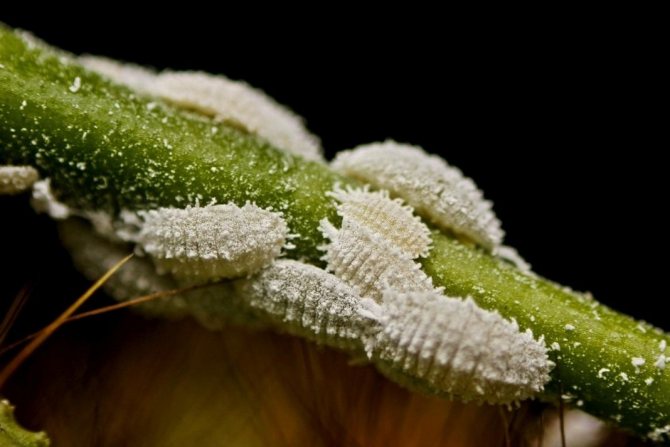

If insects are found, the plant must be treated with tobacco or garlic tincture, as well as soapy water. If there are a lot of pests, it is better to use complex insecticide preparations. When working with them, you need to be careful, and after a day wash off the remains of the solution from the leaves in order to protect the anthurium from toxic effects.
Yellow leaves
Yellow spots on the leaves of anthurium are the first signs of florist errors. The most common reasons for their appearance are:
- Illiterate watering or the use of hard, cold water.
- Unregulated application of nutrient formulations.
- Dryness of the ambient air, especially in winter when the central heating is on.
- Keep in a dark place.
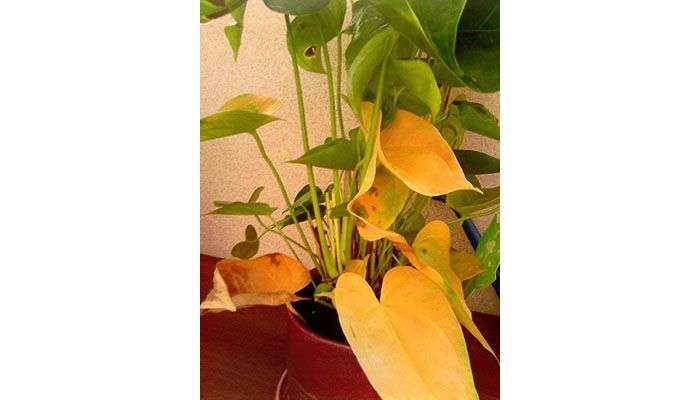

As a result of prolonged maintenance of a flower in a room with improper conditions, it is depleted, yellowness spreads and fungal infections occur or rot is formed.
But before you determine the disease of anthurium and the way how to treat the trouble, you should observe the nature of the drying out of the leaf. Perhaps this is the natural aging of the leaf plate. Age yellowness starts from the edge of the leaf and spreads to its center. Over time, the leaf plate loses its juiciness, turns brown, dries and falls off. Many gardeners are wondering: is it necessary to remove yellow leaves? Professionals recommend using a clean instrument for the procedure, and sprinkle the cuts with crushed charcoal. It is necessary to remove the yellow plates, since they not only reduce the decorative effect, but also draw food from the plant.
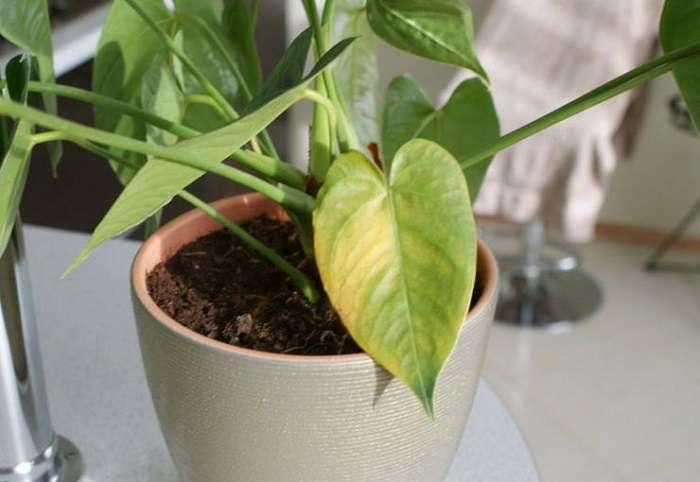

If the leaves of the anthurium turn yellow, and the reason is improper care, the grower should establish the conditions of detention as soon as possible and help the plant renew its strength. If the cause is fungal infections, then you cannot do without the use of chemistry.
Are the tips of the leaves dry on the anthurium? Why is this happening and what should be done?
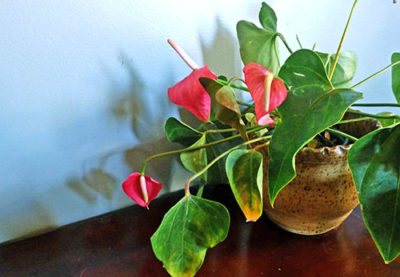

The process of yellowing and drying of the leaf in anthurium is inevitable - this is how the plant gets rid of old and unnecessary processes. At the same time, new leaf plates appear.
But what if the tips began to dry en masse, even in young leaves? What could be the reason?
What pests can attack this flower? What to do to combat them? You will learn about this in this article.
Anthurium rust
In case of a disease, on the upper part of the leaf plate, you can see spots of irregular shape, painted in a light yellow color, and on the lower side of the leaf - brown spots, pustules. With the development of the disease, the spots spread throughout the leaf, the plate withers and dries up. Treatment is carried out with the use of fungicides. If the spots spread further, you will have to cut off the affected parts of the plant.
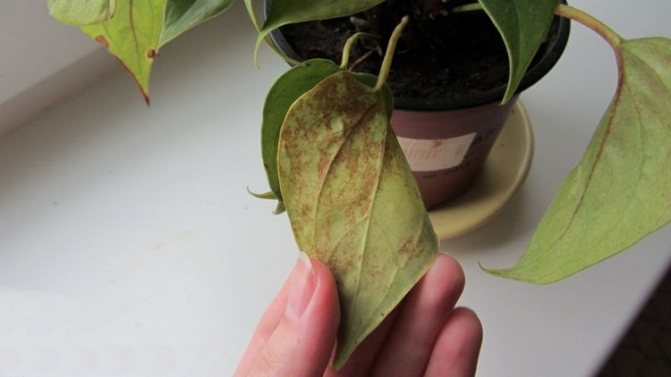

Why is this happening and what to do?
Wrong temperature
Anthurium - a plant from humid hot countries... In winter, the optimum temperature for the viability of a flower is only eighteen degrees, and in summer, despite the flower's homeland, it is considered normal if the mark on the thermometer does not exceed twenty-six degrees. At the same time, anthurium does not like drafts and easily freezes on them.
Read also: How to grow a red maple on the site
If, nevertheless, the leaves began to dry out due to the wrong temperature, it is urgent to create comfortable conditions for the anthurium: rearrange it to a colder / warmer place where no drafts can reach the flower - this is monitored especially carefully.
Illiterate watering
Having found that the tips dry out due to the quality of the water, due to too many salts and heavy metals in it, you need not hesitate and switch to watering with another liquid with a better composition. A variant with water infusion is possible: running water is poured into a bottle and costs two to three days. After a few days, you can use it for watering: the composition improves, the liquid becomes less harmful. The main thing is that the water is at room temperature.
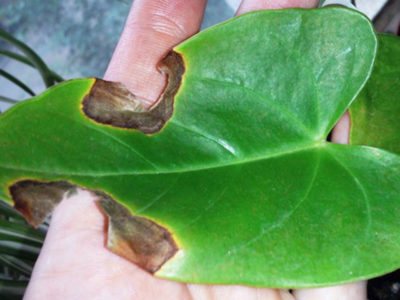

Anthurium is often attacked by ticks, scale insects or mealybugs... Having found traces of insects on the stem, leaf plate, leaf stalks and axils, flower growers treat anthurium with soapy water. A gram of nicotine sulfate is added per liter of water. A day after treatment, the plant is washed with clean water. Pre-growers take care of protecting the soil from waterlogging during the procedure.
In the fight against parasites, a solution of feverfew, tincture of tobacco or "Karbofos" can also help.
It affects not only the leaves, but also the root system of the plant. When dry spots appear all over the leaf, the anthurium is removed from the pot and its roots are examined. If they suddenly turned from white / light brown to brown or black, and the fabrics are soft and slimy, then the plant is transplanted, but before that it is important:
- remove soil residues;
- cut off damaged leaves;
- cut the roots affected by the fungus to healthy tissues;
- process the sections with crushed coal;
- treat the entire plant with a fungicide.
After moistening the soil, excess liquid is poured out, and before the next watering, the top layer of the earth is waiting for drying.
Pot does not fit
Anthurium, the reason for the drying leaves of which was the lack of free space in the pot, and therefore the lack of oxygen, requires an emergency transplant. The new container should be two to three centimeters larger in diameter, it is advisable to add more coarse fraction to the soil: cones, pieces of brick or charcoal.
If desired and at the right time, the plant is rejuvenated and planted.
Lack or excess of fertilizers
Excess nutrients in the soil cannot be corrected.In this case, the plant is transplanted into a "poorer" soil and the recommendations for the use of dressings are strictly followed. The disadvantage is compensated by an increase in the dose of top dressing.
Ground not suitable
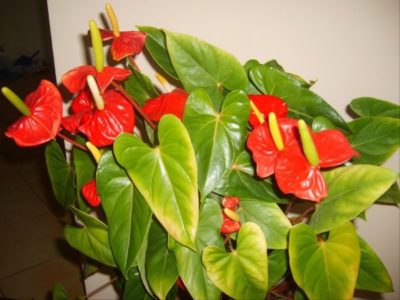

Too dry soil or, conversely, waterlogged soil can lead to unpleasant consequences for anthurium, right up to his death. Therefore, it is important to observe the watering regime and not flood the anthurium. It is necessary to remove excess accumulated water from the sump in time, monitor the quality of drainage and dry air.
A rapidly drying substrate indicates dry air. Then they try to moisturize it in every possible way:
- spray the plant water at room temperature;
- rub the leaves (but it is impossible to allow the lingering drops on the leaf plate - anthurium can cause a burn);
- set off the plant, because the sun's rays, especially direct ones, not only harm the leaves, but also dry the earth.
In summer, it is recommended to place the pot on a wide base with wet coarse sand or pebbles. When watering with tap water, the composition of the soil can change, the same effect is given by an excess of fertilizers. In the first case, the anthurium is watered with water that has been infused for several days, in the second, it is transplanted and then the amount of dressings given is monitored.
Anthurium pests
Often small midges (wine flies) become uninvited guests of indoor flowers, although they are unpleasant, but practically harmless, the appearance of the following insects, sucking juice from anthurium, is much more terrible.
- Aphid. Usually introduced "from the outside" with other plants and very quickly spreads to indoor flowers. For treatment, wash the affected areas with soap and water, after covering the soil with a package, treat with onion infusion (15 grams of finely chopped onions or 6 grams of dry scales are insisted in 1 liter of water for 5-7 hours), Fitoverm, and in advanced cases - Aktellik, Karbofos , Fitoverm, Iskra, Biotlin.
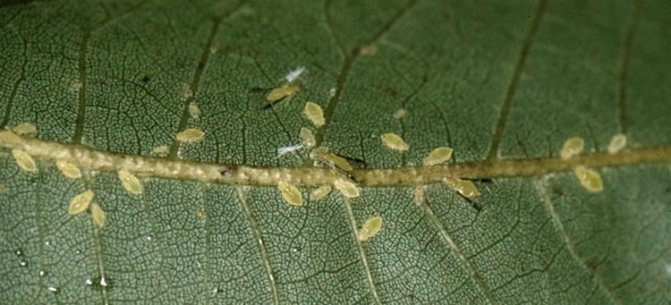

- Thrips. Thin midges up to 2 mm long. Suck the juices from the leaf. Appears in a humid environment at high temperatures. Treat with Fitoverm, diluting according to the instructions on the package. Processing is carried out several times every 5-7 days.
- Shields. They cover not only the leaves, but also the stems of the plant, suck out the juices, and are easily removed with a needle. Since the insects are covered with thick scales, it is necessary to manually collect the scabbards, and then treat the anthurium with a solution of crushed garlic (mix 1 part of garlic with 1 part of soap and 3 parts of water, insist for a day), if it does not help, wipe the stems with a cotton pad dipped in kerosene.
- Spider mite. Spawns in a dry and hot place. It entangles young shoots with a cobweb, sucks the juices from the leaves, leads to the death of most of the leaves. It is better to immediately apply Fitoverm, and not only on the affected plant, but also to treat neighboring plants for prophylaxis.
How to care for a flower "male happiness"?
- Track the location of the flower under the sun.
- Do not leave drops on the sheet plate.
- Wipe and spray periodically.
- Inspect for pests every few days.
- Cut off non-viable and diseased leaves.
Anthurium is a whimsical plant, but if you take care of it and react in time to the dry tips that appear, then it will delight you with its appearance and shiny, smooth, luxurious leaves for a long time to come.
Pests
Why do the leaves of a Chinese rose or hibiscus disease turn yellow
Indoor anthurium, in addition to diseases, can dry out or rot under the influence of insects: aphids, thrips, spider mites, scale insects or whiteflies. When pests appear, a soap solution or insecticide will be required; the culture will have to be processed every 2-3 days.
Aphid
It is easy to recognize the defeat of anthurium by aphids by yellow, twisted leaves, sticky secretions, the plant begins to die quickly. The simplest pest control measure is a warm shower or spraying the plant with soapy water (20 g.laundry soap for 6 liters of warm water). A more effective solution will be the use of drugs: "Antitlin", "Aktara", "Actellik".


Aphids on anthurium
Thrips
Leaves affected by thrips are covered with light yellow spots of various parameters and shapes. The parasites are located at the bottom of the leaves and are characterized by a brown tint. The threat of thrips is achieved by the spread of the rust virus. The optimal environment for unwanted guests is high humidity and temperature. It is necessary to adjust the indoor climate. To treat a flower affected by thrips, drugs of high toxicity will help: "Tanrek", "Actellik" or "Fufanon".
Spider mite
Spider mites give out small yellow specks on the outside of the leaves, merging into huge spots. A cobweb full of small insects appears at the bottom of the leaf. Mites love heat and dry air. As soon as the flower turns yellow, it is important to urgently treat the leaves with soapy water, remove insects and wipe with mineral oil. Adjust the humidity and temperature regime.
Shield
Whitish or golden brown tubercles on the leaves of anthurium are the first signs of a scale insect that sucks out the life juices of a home flower. An ordinary needle will allow you to remove the pest from the sheet. Single individuals are also brushed off with a toothbrush, wiped with a cotton swab soaked in kerosene - under the kerosene film, the shield will suffocate.
On a note! Florists often experiment with an oil-based spray for polishing anthurium leaves. With the active reproduction of parasites, an insecticidal solution should be made and mineral oils should be prepared for processing greenery.
Whitefly
The flower looks depressed, leaves curl and discolor, buds and flowers fall off. It is worth carefully examining the pet, especially the underside of the leaves. Perhaps the plant has become a haven for insect pests - whiteflies. Small moths with many larvae suck out the vital juices of the anthurium. The whitefly discharge on the upper part of the leaf resembles a sticky shiny bloom, similar to sugary streaks, in consistency. When a whitefly appears, experts advise to resort to the use of chemicals: Aktara, Confidor, Akarin, Iskra, Fitoverm, Aktellik, Tanrek.
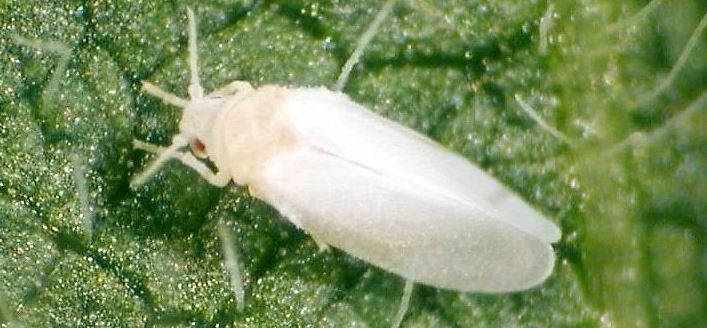

Whitefly on a healthy plant
Why do anthurium leaves dry at home
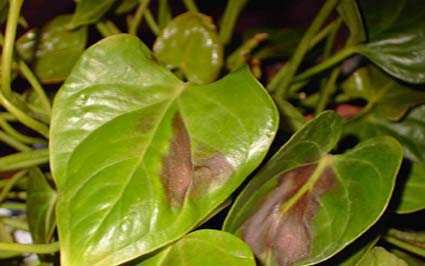

The optimal microclimate for anthurium is an important condition not only for flowering, but also for the health of the deciduous mass. A plant brought to us from the South American tropics requires high humidity, regulated watering and other essential aspects of proper maintenance. Otherwise, spots appear on its leaves, the tips dry, and the bush itself may even die if the grower does nothing.
Watering disturbance
If you are going to start an anthurium, know that this flower will require constant attention and care. Watering properly will ensure that the leaves never begin to brown or turn yellow. The root system of the plant suffers from too moist soil, and then the whole bush becomes sick. Drying of the substrate is also undesirable, since it is fraught with similar consequences.
Read also: Duranta: description and features of home care
To organize proper watering, you must:
- Moisten the soil only after the top layer of the substrate has dried;
- Drain the moisture that remains in the pallet;
- Reduce watering during the cold season;
- Moisten the soil often in summer, but in small portions.
It is imperative to use settled water at room temperature with reduced hardness for irrigation. If possible, filter it better or add oxalic acid (0.5 teaspoon per 5 liters).
Dry air
Anthurium leaves can also dry out due to dry air. The plant is deficient in moisture as it evaporates quickly.In tropical forests, bushes grow in high humidity conditions, therefore, for the health of the bush, it is necessary to organize a similar microclimate.
There are several ways to increase humidity:
- Put a pallet with expanded clay or sphagnum moss poured with water near the pot with anthurium;
- Spray the leaves regularly with a spray bottle using water at room temperature (it should not fall on the inflorescences, if any);
- Install a humidifier in the room;
- Wash anthurium under the shower several times a month.
When the leaves dry from the tips in winter, this is a sure sign of exposure to heating appliances. That is why it is not recommended to place the anthurium near the batteries, but place it a little further from the window, in partial shade.
Other causes of leaf drying
Dry air and unregulated watering are not the only reasons why the foliage of anthurium loses its attractiveness:
Yellow spots
Leaves turn yellow in winter due to lack of light. Watering with chlorine and heavy metal oxides can also lead to this phenomenon. If you want to avoid yellowness, it is recommended to water the plant with rain, melted or pre-separated water at room temperature. If water accumulates in the pan, the roots will begin to rot and the leaves will turn yellow. It is necessary to moisten the soil moderately, remove excess liquid from the pallet. A flower in a small pot can also produce yellow leaves. Then it must be transplanted into the largest container.
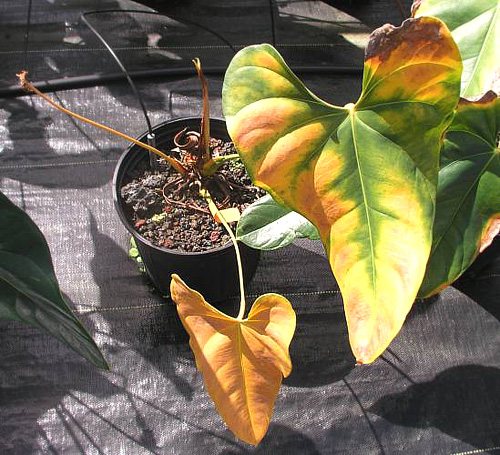

Anthurium pests and fungal diseases: what to do
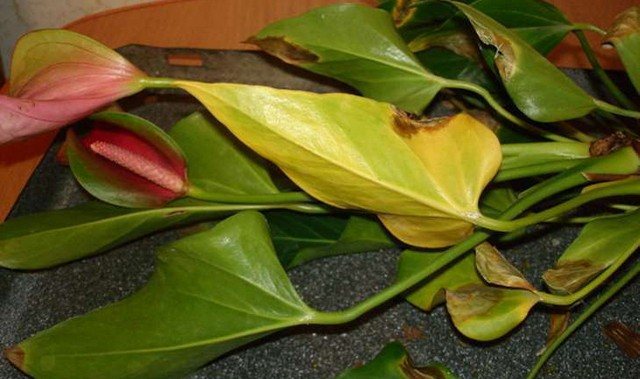

The reason for the drying of the leaves of anthurium when kept at home and with proper care can be infection with pests or fungi:
The rot that affects the root system of the anthurium also affects the condition of the entire bush. Not only the tips begin to dry, but also the whole sheet plates. Determining the presence of a fungal disease is simple - just pull the plant out of the pot and carefully examine the roots. If they are brown or black, covered with bloom and soft, then the plant needs to be urgently reanimated:
- Remove all old substrate from the roots, remove all affected processes;
- Trim off yellow, dry, or suspect leaves;
- To treat the places of cuts on the roots with crushed activated or charcoal;
- Spray the entire bush with a fungicide solution;
- Plant the plant in a new pot with a replacement soil, after sterilizing it.
Blackening of foliage
The wrong content of anthurium leads to the appearance of diseases. One of the most common is the blackening of the leaf plate. Reasons for curling, blackening and drying out of the leaves of a flowering bush:
- Watering with hard water stimulates an increase in calcium and a decrease in magnesium and potassium in the soil. An excess of the trace element leads to poor absorption of food and blackening.
- Cold water with a high lime content is the cause of the loss of immunity.
- Black bloom on the leaves indicates an invasion of pests. This disease is popularly called black fungus. It can lead to the death of a bush in a matter of days.
- Frequent watering and the use of cold water means that the root system does not have sufficient air access. She simply suffocates and decays.
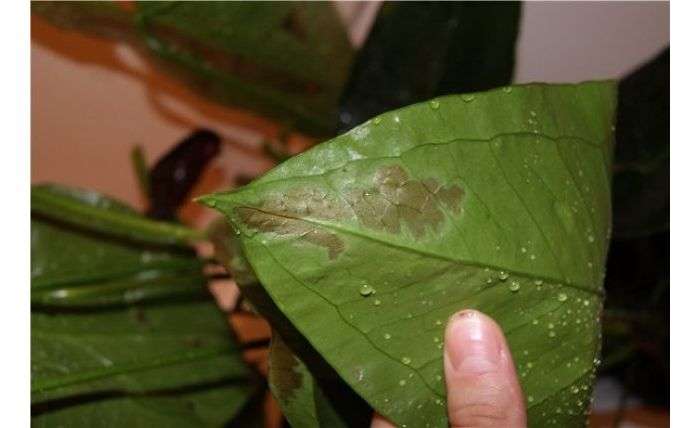

How to prevent leaves from drying out
It is much easier to organize suitable conditions for anthurium than to treat a drying bush later. Thus, in order for the plant to feel comfortable, it is necessary:
- Place the pot on the eastern or western windowsills in the summer, and in the winter move to the southern ones;
- Water the flower sparingly, only after the substrate dries;
- Organize a high-quality drainage system to drain water by making holes at the bottom and placing a drainage layer in the pot (1/3 of the total height);
- Avoid direct sunlight on the leaves;
- Spray the bush and wash it regularly;
- Use a suitable primer with the required acidity (5.5-6.5 pH).
Timely transplants (once a year) with a change of substrate will help to avoid nutrient deficiencies and keep the flower healthy.
The wrong fertilizer
If there is a lack of nutrients and elements, then slow growth is noted, young small leaves. The leaf plates become brown due to a lack of nitrogen, potassium, phosphorus, calcium or magnesium. It is recommended to feed a houseplant with ready-made liquid products. The affected anthurium is fed once a week. When the flower regains strength, feeding is reduced to once every 2 weeks. With an excess of fertilizer, brown dry spots on the leaves of anthurium can also form. To save a flower, you need to transplant it into a new soil, washing the roots.
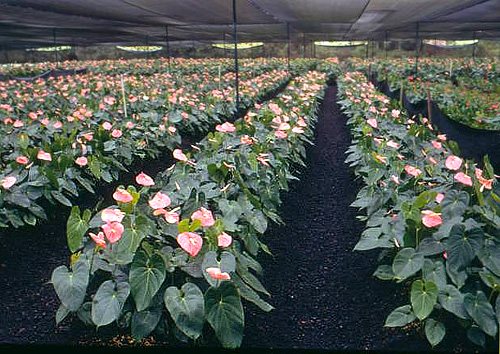

Anthurium care at home - why do the leaves dry?
Indoor flower anthurium can decorate any room and transform even the most boring interior. The plant has dense glossy leaves and heart-shaped flowers. The color of anthurium flowers can be from light pink to maroon. When you see a plant for the first time, you might think that its leaves and flowers are made of plastic.
Most often, anthurium is used as a houseplant. When kept at home, the flower requires special care. Experienced growers consider the plant to be very unpretentious. But amateurs may face some problems, the solution of which will be discussed in our article.
How to propagate a plant?
When anthurium is in an environment suitable for its growth, it, like all other flowers and plants, begins to multiply. This happens by the appearance of small shoots near large plants - "children". Separating them is the most common way to reproduce a flower. It is advisable to do this directly during the transplant. Very carefully, the shoot is separated from the adult plant with a knife, and the cut is rubbed with charcoal. Next, the anthurium is planted in a separate pot according to the technology
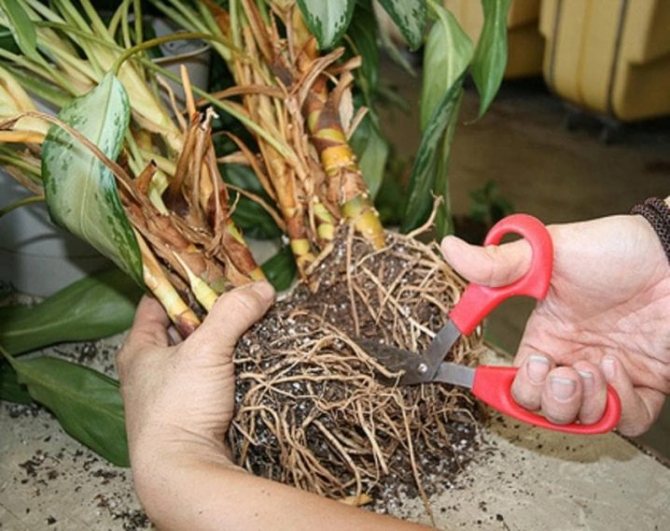

There is another method that involves propagation from the stem. To do this, the stem with the leaf is placed in a container of water, covered with a glass jar to create an air dome. After a while, the stem will take root, then it will need to be planted in a pot.
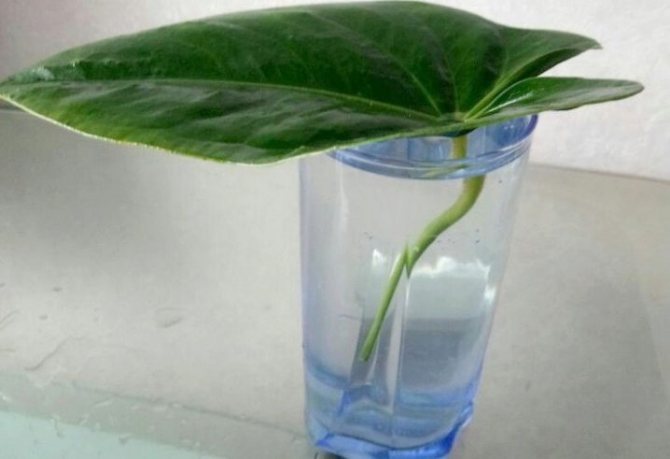

There are cases of seed reproduction of anthurium, but at home this procedure is extremely painstaking and almost impossible.
What to do if anthurium has brown spots on the leaves, see the next video.
Brown spots on the leaves are often found in anthurium. This phenomenon is considered a bad symptom, since anthurium is a luxurious houseplant, which has weighty shiny leaves and beautiful flowers. Therefore, it is important to know why anthurium has brown spots on the leaves, as well as how to fix the problem. If you do not know how to independently solve the problems that have arisen, contact an experienced florist for advice.
Features of anthurium care
First of all, you need to know that the plant does not tolerate high temperatures and direct sunlight. In summer the air temperature should be in the range of 20-23C, and in winter - 16-18C... A well-lit place is chosen for the anthurium. With a lack of light, the plant will stretch out, and its flowers will fade. Avoid direct sunlight.
When caring for an anthurium, you must follow some rules:
- The plant loves regular watering, however, it does not tolerate stagnant water. That is why a wide pot should be chosen for it, on the bottom of which a drainage layer is laid. The superficial root system of a flower is capable of picking up moisture from the air. Therefore, it is recommended to cover the topsoil with moss, which will need to be periodically sprayed.
- The plant needs high humidity. To ensure such conditions, anthurium leaves must be constantly sprayed with settled water. The air humidity can be increased using a purchased humidifier, or by placing the plant pot on a pallet filled with wet expanded clay, peat or moss.
- Anthurium is not particularly demanding for feeding, but it needs additional nutrients. Fertilize the plant about once every two weeks from March to October. Foliar dressing for flower leaves is very effective. They can be sprayed on the plant once a week. Organic matter is applied to the surface of the substrate.
- The acquired plant from the container is transplanted into a pot filled with special soil. You can use an earthen mixture designed for orchids and bromeliads. The substrate should be breathable, loose and contain coarse fibers. The permissible soil pH is from 5 to 6. The transplanted flower is well watered. In the future, caring for him consists in frequent spraying and careful watering. The first time after transplanting, the plant is very sensitive to a lack of moisture.
- Anthurium propagates at home by cuttings. To do this, the apical cuttings with aerial roots are separated from the main plant and planted in a separate container.
Read also: Why blue cyanosis is useful for the body
These are all the rules that you need to know when caring for an anthurium. But if, nevertheless, the flower is sick, then the recommendations below will help to save it.
Aging leaves of anthurium
Like other plants, the leaves of anthuriums can turn yellow for a completely natural reason, due to old age. In such cases, the inevitable processes primarily affect the foliage located closer to the ground.
Yellowness, spreading from the edges of the leaf plate, gradually covers it completely, the leaf loses its elasticity and juiciness, and then turns brown. If it is not removed, such an anthurium leaf dries and falls off on its own. If the plant is kept in proper conditions, then the fall of old leaves does not harm the anthurium, because at the same time, new healthy foliage is actively appearing at the top of the stem.
Since the process is natural and inevitable, there is no need to worry about it. However, flower growers often have a question: "Is it necessary to remove yellowed or dry leaves of anthurium?"
Obviously, such leaf plates no longer perform their main function, but the plant spends certain forces on their maintenance. Therefore, it is better to cut off the leaves that have become obsolete, making life easier for the entire plant and making it more attractive.
To prevent the cut from becoming a place for the spread of infection, it is useful to treat the cutting tool, whether it be scissors or a knife, with alcohol, and sprinkle the damaged tissue on the anthurium with chopped charcoal.
If the leaf still retains its juiciness, you should not tear it off by hand, because this can seriously injure the stem.
In addition to natural reasons why anthurium leaves become stained or dry, flower growers have to deal with the consequences of mistakes they made when caring for a houseplant.
The main problems when growing anthurium
The main difficulty in caring for a plant at home is the problem with flowers and leaves. They are may begin to curl, stain, or dry out... There can be many reasons for this.
Why do anthurium leaves dry?
The main reasons why the leaves begin to dry:
- dry air;
- insufficient watering;
- anthractosis and other diseases;
- defeat of aphids.
The regularity of watering the plant should depend on the season. In summer, watering can be plentiful, and in winter, if the room is cool, anthurium is rarely watered... The soil should dry out by 1/3 of the pot between waterings. The air humidity can be increased by daily spraying of the leaves.
If the leaf begins to dry from the edges, and then becomes thinner and dries up completely, then the anthurium is affected by anthractosis. In this case, trequires treatment with a systemic fungicide.
Curled and wrinkled leaves with light spots indicate a greenhouse aphid infestation of the flower. To get rid of the pest, you can use the drug "Aktelik" or "Karbofos".
Why do brown spots appear on the leaves?
In this case, there can be three main reasons:
- If the spots are large, then there is a problem with feeding the plant. It is imperative to use only special fertilizers that contain balanced substances.
- Small brown dots on the leaves indicate that the room temperature is too low.
- If spots are found, it is necessary to inspect the stem and the inside of the leaves of the flower, as it can be affected by the mealy worm. In this case, the use of special chemicals will help.
Why do leaf tips dry?
- dry indoor air;
- insufficient oxygen is supplied to the root system.
In the first case, in winter, the pot with anthurium must be removed away from the heating devices, and the plant should be regularly sprayed at any time of the year.
In the second case the flower is recommended to be transplanted into the groundby adding charcoal, pieces of bricks or cones to it. After adding the coarse fraction, the soil will become looser, and oxygen will flow well to the roots.
What if the leaves turn black?
There may be several reasons:
- draft;
- direct sunlight;
- excess of calcium salts in the soil;
- low or high room temperature.
If the pot with anthurium is in a room where there are constant drafts, then its leaves will begin to turn black and curl. Therefore, the flower must be rearranged in a place that is safer for it.
Anthurium should be shaded from direct sunlight, otherwise a burn in the form of black spots will appear on its leaves.
You can recognize that there are a lot of calcium salts in the soil by the limescale, which manifested itself on the inside of the pot. If a the soil cannot be completely replaced, then it is enriched with peat or humus, and watered only with settled water.
Inappropriate temperature conditions when caring for anthurium can lead to the appearance of black spots on its leaves. It must be remembered that the temperature in winter should be within +18C, and in summer not higher than + 26C.
Why do the leaves turn yellow?
By yellowing the leaves, anthurium reacts to a number of reasons:
Leaves dry
Anthurium leaves dry due to too dry air, poor watering, diseases, aphids. The frequency of watering will depend on the season. The soil should dry out by about a third of the pot between waterings. To increase the humidity of the air, spray the leaves with water daily. When the leaves dry out at the edges, and then completely dry out, it means that the flower has suffered from anthracnose. Treat the plant with a systemic fungicide to combat the disease.
Dried tips can form due to a lack of oxygen directly in the root system. Transplant the anthurium into soil with cones or charcoal.
Optimal growing conditions
Anthurium moved to our apartments from the tropics of Central and South America, so he got used to shading. The best place in the apartment for him will be the window sills of the western and eastern windows. The optimum growing temperature is 16–20 ° C in winter and 20–25 ° C in summer.
Anthurium is a big lover of moisture. Like many tropical plants (zamioculcas, monstera, calla), with high soil and air humidity, anthurium is able to "cry" due to special pores on the leaves. But it is worth remembering that in everything you need to know when to stop. A non-drying, moist substrate will quickly lead to root rot and death of the plant.
The soil for anthurium, as for most epiphytes, should be fairly light, slightly acidic. An excellent option is ready-made special soil mixtures for aroids.
Important! All parts of anthurium, like most plants of the aroid family, contain poisonous sap, so it is necessary to isolate it from small children and pets.
Gallery: variety of colors of anthurium flowers
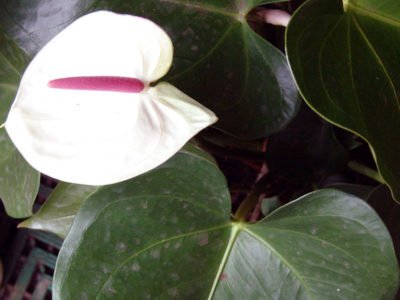

Spectacular white anthurium White Hart will not leave indifferent any grower


The purple anthurium Fiorino has a simple laconic inflorescence that looks very beautiful in a bouquet
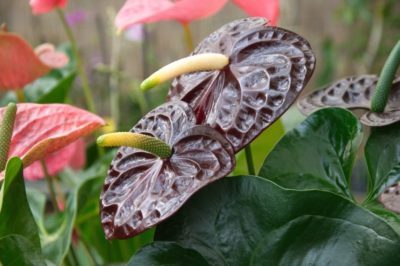

Anthurium Black Queen has an original look - as the bud opens, the flower changes its color from cherry to almost black.


Romantic natures will love the exotic blue Anthurium Princes Alexia Blue
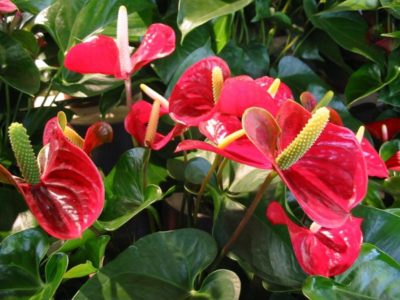

Red anthurium Andre is the ancestor of modern species of anthurium
Lack of flowering of anthurium
The problem is more often associated with a violation of the conditions of detention. In much rarer cases - with infectious diseases. The following factors can cause the cessation of flowering:
- too cool outside temperature (below +18 degrees);
- finding a plant under drafts;
- exposure to direct rays of the sun;
- stagnant water in the pot.
The last reason is the most common. Anthurium roots are very sensitive to the level of soil moisture, and it is critical for the plant to allow the soil to become waterlogged.
They cause flowering in this case by eradicating the cause that gave rise to the absence of buds. In any case, additional feeding with complex minerals will not hurt.
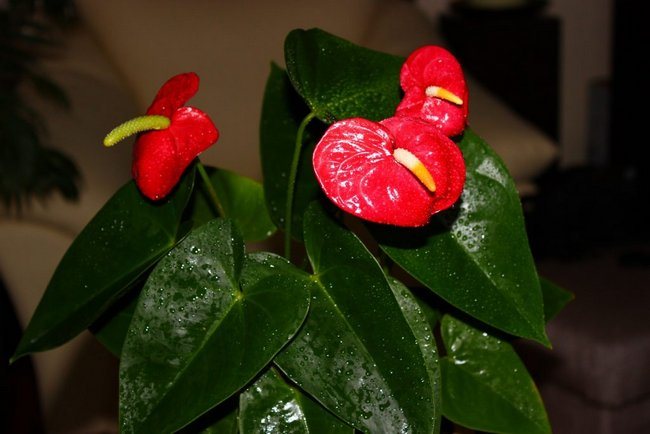

Today, there are many drugs that allow you to keep the flower in a healthy state for many years. However, one should not neglect methods of prevention, because it is much easier to prevent a plant disease than to treat it even with the most modern means. Caring for home flowers anthurium, in principle, is simple. Most importantly, with the right approach, this plant will surely thank you. Anthurium of Andre and Scherzer - year-round flowering, crystal anthurium - with large spectacular leaves.
Brown leaves of anthurium, what to do
The brown color of the leaves of male happiness is not uncommon. Trouble can happen through the fault of the owners - an incorrectly selected substrate affected the natural shade. To fix the mistake is simple - to purchase a ready-made soil mixture designed specifically for this type of indoor plants.
Important! Transplant carefully, taking care not to harm the root system. Root trauma will not allow to get rid of the brown color, and the emerging from warm edges will be an unnatural shade for a long time until it takes root in a new substrate.
Brown greens can also become at the wrong temperature. Hypothermia of the soil in a pot is especially harmful. The mistake of the owners is the content of anthurium on a cold windowsill. It is not difficult to avoid the disease - put a thin sheet of polystyrene under the pot - the insulating material will not allow the root system to overcool.
Hard water can also affect the color of the aboveground part of the bush. Long-term boiling and settling will help to make the liquid softer. The process is laborious, but before growing behind the anthurium, one should prepare for considerable difficulties, including watering.
Anthurium white - species and varieties
In theory, the anthurium flower is the ear itself. In white specimens, it is long, up to nine centimeters, and the bedspread is heart-shaped and in different shades, along with white. It can be white and pink, with a yellow or greenish tint, depending on the variety. As for the varieties of these plants, the Man's Happiness flower (and this is how it is most often called among the people) has been very successful in this regard. Among the white representatives, there are a large number of varieties, not to mention representatives of other colors.The most popular among them are Andre and Scherzer, among which you can find the cherished snow-white handsome.
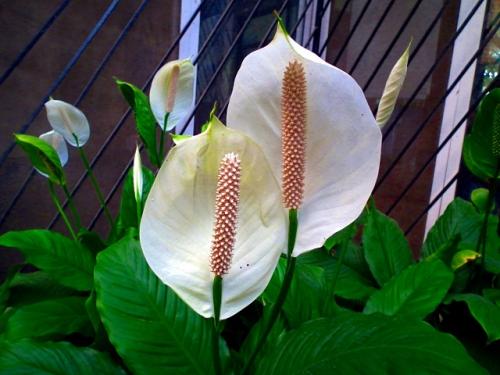

Scherzer's flower should be said separately, since, unlike the Andre variety, it is more unpretentious and feels much better as a houseplant. It has a short stem, its alist is dense, dark green, with a characteristic matte sheen and small dark dots. It blooms intensively, it can produce up to five inflorescences at a time, which looks very unusual, given their different sizes.
In addition to the unpretentious Scherzer anthurium, there are several more notable white varieties:
- Acropolis - differs in large bedspreads and leaves in the form of dense ovals;
- Champion White is a low-growing variety with an original appearance: its ear is yellow, which looks very attractive in combination with a snow-white bracts. The older the Champion gets, the greener his ear and bracts are;
- White Heart - spectacular and bright, with a bright pink ear, which looks just wonderful against the background of a white bedspread;
- Princess Amalia Elegance is famous for its white bedspreads with bright pink veins and a cob of the same color. A very delicate and unusual flower.
Pest infestation
The plant can also be affected by harmful parasitic insects. Next, we will get acquainted with the most common pests and find out how to get rid of them.
Aphid
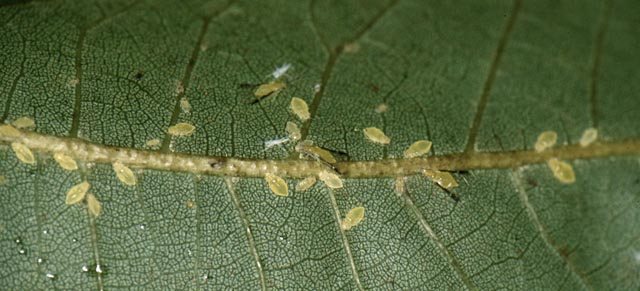

This miniature parasite, despite its tiny size, does considerable harm. The aphid settles on the bottom of the leaf and sucks out the juices of the plant. The insect colony reproduces at a rapid pace.
What to do
Since pests multiply very quickly, you need to get rid of them quickly. Fortunately, removing aphids is easy: you just need to buy the right insecticide and treat the plant. A day after treatment, the leaves should be rinsed with water to wash off dead and still living insects from them. And such washing of the leaves will protect from chemical burns.
Shield


This pest is more dangerous than aphids. The scale insect settles on the leaves and stems of anthurium and feeds on its juices. The insect has a good camouflage and it is quite difficult to spot the parasites.
What to do
When the scabbard multiplies, the insects can be seen with the naked eye: then treatment should be undertaken urgently. The flower must be isolated from other plants and rinsed with water.
Then insecticidal treatment is performed, after which the flower should be washed again. There should be two treatments in total. If the scabbard has not yet had time to multiply, you can try to cope with it with a regular soap solution.
Mealybug
This pest is the easiest to deal with, since you can notice it almost immediately. The worm covers the leaves with a whitish bloom, which immediately catches the eye. However, if rescue measures are not taken quickly, the worm can even destroy the anthurium.
Prevention measures
Proper care of green pets avoids a lot of problems. Timely and rational watering, sufficient fertilization, optimal lighting and air temperature will allow the flower to feel good and delight the owner with its beautiful flowering.
Unlike fungal diseases, which often appear with improper care, parasitic diseases damage even well-groomed plants. To avoid many problems, you need to closely monitor the anthurium and inspect the leaves for the presence of pests.
For preventive purposes, it is recommended to arrange shower from time to time for the plant, wash it with a solution of laundry soap. And if the pests were nevertheless noticed, it is necessary to immediately begin to combat them.
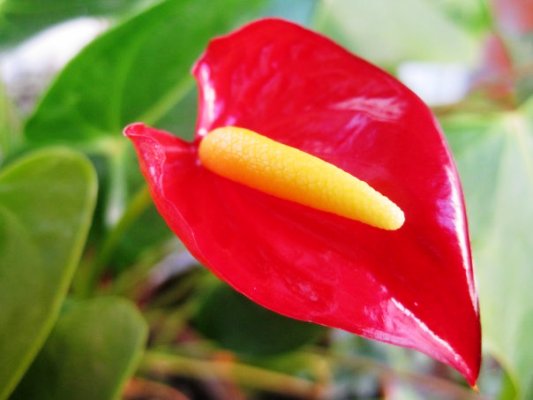

Insect harm
Anthurium can become a victim of pests, and in most cases insects that are common for indoor crops settle on it.These include thrips, scale insects, aphids and spider mites.
The danger of pests is not only that they feed on the sap of the plant and spoil its appearance, but also that such an effect significantly weakens the crop, making it more susceptible to disease.
The video discusses the main factors that can provoke yellowing of the leaves, as well as the main ways to solve this problem.
Drying of deciduous mass
Lethargy and dry foliage are signs of the manifestation of diseases. Sick (these symptoms are quite dangerous) plants in the same room with healthy ones should not be. The first step is to isolate the affected flower to avoid massive contamination of indoor vegetation.
Outwardly spectacular anthurium is able to make it clear that the care for it is not carried out well enough. One of these symptoms is complete desiccation of leaves. First of all, a lack of moisture leads to this state. Since anthurium comes from humid and hot tropics, it needs a sufficient amount of moisture in the room for a comfortable existence.
Since the leaf plate of the flower is quite wide, it quickly loses moisture, especially when exposed to air flow. A draft dries up the leaves of a flower most quickly. In order for the plant to return to normal, you should adjust the temperature and humidity level in the room, which can be measured using a hygrometer. Also, the plant should avoid drafts, but the room should always be well ventilated.
Diseases of a non-infectious nature
Improper plant care contributes to the emergence of diseases. Smallpox, chlorosis, enations are considered non-communicable diseases.
Plant pox
With a disease caused by mistakes in care, various convex spots appear on the leaves. They can be colored yellow or yellowish green. Such ugliness of the sheet plates can occur when the air humidity does not match the temperature.
On a note! We must not forget about the timely feeding of anthuriums. After all, healthy specimens are less susceptible to diseases.
Chlorosis
The disease occurs as a result of a deficiency of two important elements - iron and magnesium. Their lack is manifested in the yellowing of the foliage or in the appearance of yellow streaks on the leaf plates.
Enaties
The disease can be recognized by the ugly leaves. The first sign is that the foliage began to grow unevenly, the plates themselves become convex and humped. Incorrect content temperature contributes to the appearance of enation. The room can be too stuffy, too cold, or dry or humid. To get rid of the problem will help the establishment of proper plant care and adherence to agrotechnical methods of cultivation.


Darkening of green mass in anthurium
The acquisition of a dark shade and drying of the leaves of anthuriums indicates the presence of a soil fungus. Several of its species form entire colonies that lead a parasitic lifestyle. The initial external sign is darkening on the leaves, black spots acquire color later. The foliage soon dries quickly and falls off. On the root surface, as well as on the lower part of the stem, you can find dark spots with a dense bloom of white.
It is this plaque that is the formative element for the dispute. At the same time, even with the naked eye, you can see small black dots that carry disease and infect other plants. The affected stem is slightly watery to the touch. Subsequently, a dense gray mold appears on the surface of the leaves and inflorescences. Young plants are most vulnerable to fungal infection, as well as flowers transplanted into a new container with fresh soil.
The fungus, multiplying in the soil, penetrates the root system of the plant.Infection is facilitated by poor-quality soil, insufficiently disinfected container for planting. Excessive watering, in the absence of sufficient drainage, as well as insufficient ventilation of the room, are also the causes of the disease. To treat a flower, remove it from the pot and place it in disinfected soil, in a new planting container. Remove all affected areas of roots and foliage. Rinse the roots in a solution of potassium permanganate.
basic information
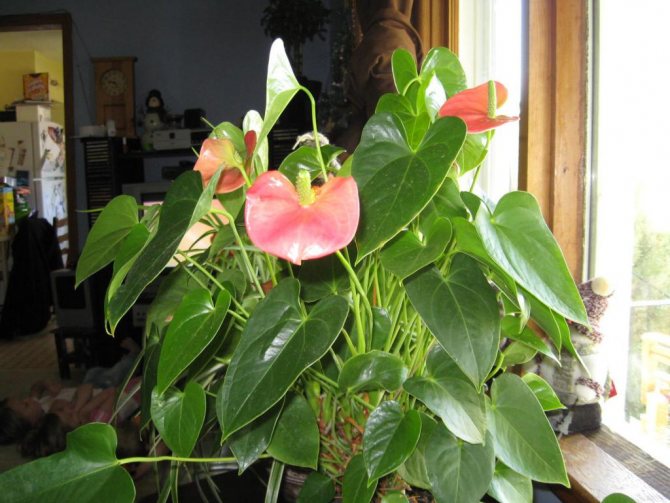

Anthurium is an evergreen plant. Its homeland is tropical forests. Due to its bizarre shape, anthurium is also called a flamingo flower. This plant is popular among both amateur and professional flower growers. By itself, it looks rather unusual. Anthurium can also be used to create various flower arrangements. Photos of such solutions will help you find the right combination. One of the unusual qualities of anthurium is the ability to stand in a cut vase for several weeks.
An important problem that all anthurium growers face is leaf disease. Photos, how to treat, methods of therapy - this information will help you identify the problem in time and deal with it. According to experienced gardeners, it is better to take measures to prevent diseases in time, otherwise you can lose the plant later.
Parasites and pests
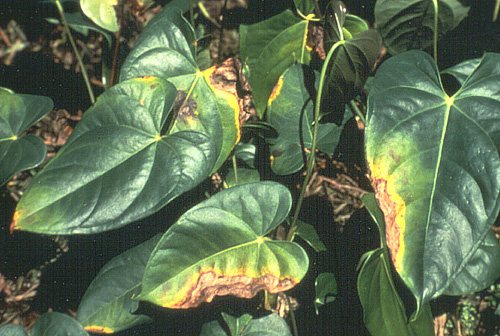

It is advisable to familiarize yourself with this aspect before you start planting a plant. Exposure to parasites and pests is also an anthurium disease. Photos and how to deal with them are important information that will help you easily solve the problem. It should be borne in mind that parasites can affect not only leaves, but also flowers, and stems, and roots of plants. The most dangerous pests include thrips, aphids and scale insects. The most difficult thing is to fight the last parasite, since at the initial stage of the disease it is almost impossible to detect it. The plant can only be cured with careful care. These small insects are able to bring the culture to complete death, therefore, it is necessary to immediately carry out mechanical cleaning and treat the anthurium with insecticidal preparations. You can recognize thrips by the black dots on the back of the leaf. If such signs are found, the plant should first be isolated from healthy flowers and treated with insecticides. For prevention, it is recommended to regularly ventilate the room.
Another dangerous pest is the spider mite. If you notice signs of the presence of this parasite on the anthurium, you can prepare for a long treatment process. The most obvious symptom is the appearance of a thin cobweb enveloping the leaves. After a while, the leaves begin to curl and dry out. Treatment involves clearing the cobwebs from the plant. You should also wipe the pot itself and the surface on which it was located. The plant itself must be wiped with laundry soap. It should also be remembered to maintain optimal growth conditions. If you start caring for the plant, the spider mite may return.
Causes of the disease and methods of treatment
Diseases of anthurium can occur even with the slightest violation of the conditions of its detention. After all, the homeland of "male happiness" is located in southern countries, so not every climate will suit him, besides, a cramped pot, a lack of light also add a fair amount of discomfort to a capricious flower. In order to avoid serious consequences, it is important on time and most importantly to correctly determine the causes of his unusual condition.


Anthurium is susceptible to various diseases. For example, it is quite vulnerable to fungus, viruses, and various infections. Moreover, you should not waste time trying to cure it using folk methods - this will only aggravate the situation and lead to irreversible consequences.Lost time can also play a fatal role in this case. The following are examples of the most common flower diseases, as well as their home treatment.
- Anthurium anthracnose (copperhead) is a fungal disease that often affects legumes, berry bushes (gooseberries, currants, raspberries). Basically, the copperhead attacks weakened specimens that have mechanical damage. High humidity also contributes to its development. Spreads with rain and wind, affected by seeds. For treatment, fungicides are required (Redomil Gold, Cuproxat). Processing is carried out twice, with a break of 20 days.
- Septoria. It appears on the leaves in the form of uneven brown spots with light edges. When viewed under magnification, small dark specks of sporangia (reproductive organs of plants that perform the function of asexual reproduction) can be distinguished. In this case, you should urgently remove the infected leaves and reduce the humidity in the room. You can heal with preparations containing copper, as well as fertilizers for flowering plants. Do not spray the leaves with water until it is completely cured.
- Chlorosis. Non-infectious disease that can be identified by the presence of pale yellow spots on the leaves of anthurium. The reason is iron and magnesium deficiency. This ailment can be easily eliminated with the help of regular fertilizing with fertilizers for decorative flowers.
- Thrips (vesiculate). These are insect pests that can parasitize almost any plant. The affected plant loses its foliage and withers. Visually, the accumulation of pests looks like a gray bloom, also consisting of their larvae and secretions. First of all, the diseased plant should be isolated, and the surface on which it was located should be treated with detergents. Then wash the plant with a sponge dipped in a solution of laundry soap and process according to the instructions with one of the following preparations: Karate, Aktelik, Intavir.
In order for the anthurium to be healthy and delight home and guests with its beauty, it is important to comply with preventive measures for possible diseases. For example, regular moderate watering, timely airing and the necessary level of humidity in the room will avoid a lot of health problems for this green handsome man.
Viral diseases
Bronze virus
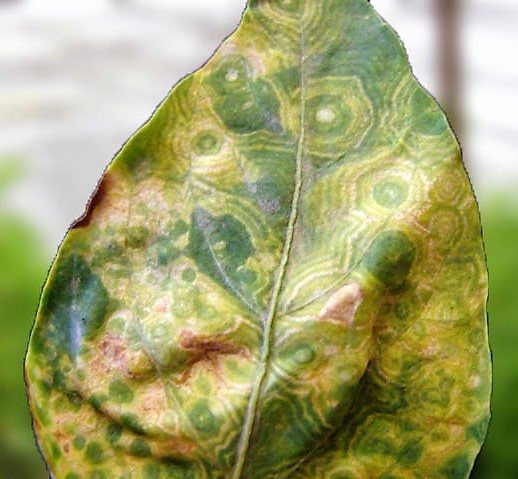

If your pet's leaves begin to partially discolor, wrinkles and small holes appear on the surface - it is possible that the anthurium has become infected with the leaf bronzing virus. This disease is usually carried by thrips from other affected plants.
Unfortunately, there is no cure, the diseased plant will have to be destroyed. Inspect the rest of the flowers for infection with thrips, if necessary, fight these pests with insecticides (aktara, actellik).
Blackening of the leaves
Let's dwell on this in more detail. What other diseases are anthurium? Photos and descriptions of problems are often associated with the appearance of blackness on the leaves. Such spots are usually formed as a result of too much watering. If you do not follow the measure in this matter, the plant can die very quickly.
Flabby black leaves are a clear sign that the transplant was not carried out correctly. For the plant to grow better, it must be transplanted into a special substrate. Soil for orchids and bromeliads works best. It includes sod, leaf and coniferous soils. The soil must also contain sand.
The reason for the darkening of leaves in anthurium is also damage to the root system during transplantation. Therefore, it is necessary to know in advance how this procedure is carried out correctly. Root diseases can also be associated with sudden changes in temperature. Brown spots around the edges can kill the plant. With advanced stages of the disease, the plant may simply not be cured in time.Therefore, you need to know how to properly care for a flower.
Buy rooted baby or blooming anthurium
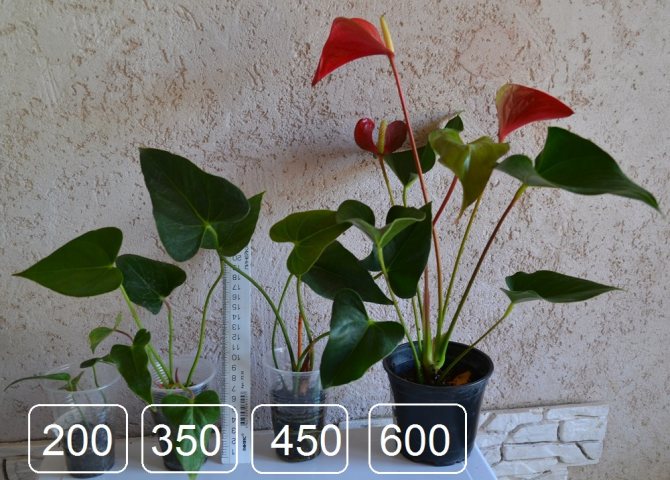

You can buy a blooming Anthurium, depending on the variety and age of the flower, in the range from 500 to 1000 rubles. A rooted shoot (little baby) of anthurium can be bought for 200 rubles. Delivery by mail is free if the cost of the ordered plants (a set of any seedlings or seeds) is 3000 rubles. The minimum purchase amount is 1000 rubles.


Anthurium catalog: photo and description.
For the presence of anthuriums in our nursery, see the section "Catalog of anthuriums".
When choosing anthuriums, instead of the name, you can indicate the number of the flower in the photo.
Other plants:
You can buy different varieties of anthuriums in our nursery. We place all the children of anthuriums in a temporary pot (plastic glass), so the anthurium bought from us needs to be transplanted into a permanent pot after receiving the parcel. Watch the video, it clearly shows how to do this.
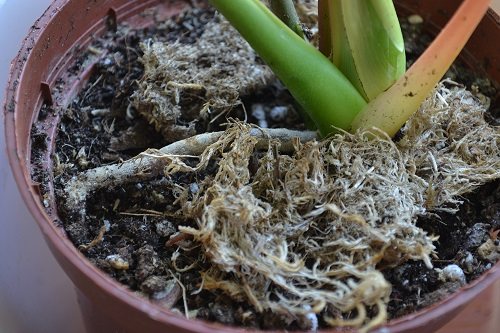

Soil and peas for anthurium
Anthuriums require a soil consisting of several components. How to make a substrate for anthurium, and which pot to choose for this flower.
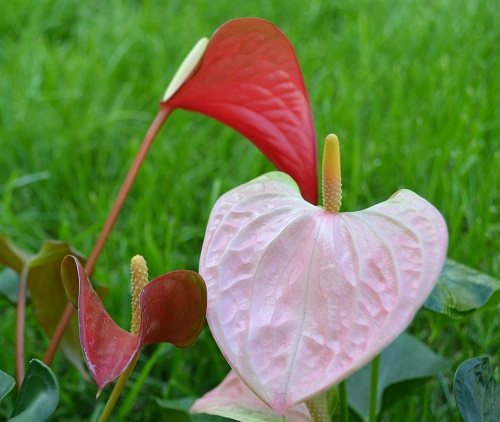

Home anthuriums: description and care
Have you bought anthurium seedlings from our nursery? Be sure to read this material. In this article you will find a description of anthurium and recommendations for care and cultivation, transplanting them at home.
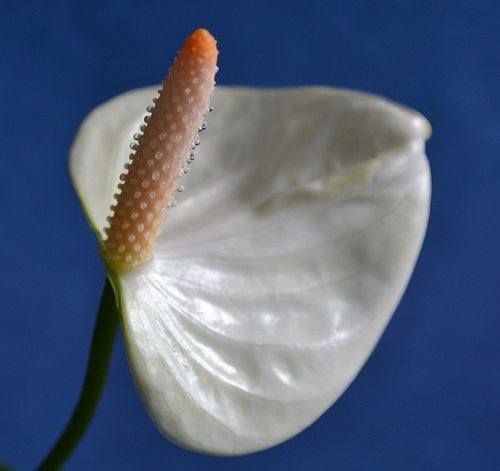

Anthuriums: Andre, Khrustalny, Scherzer
Description and cultivation of these three main types of indoor anthuriums at home.
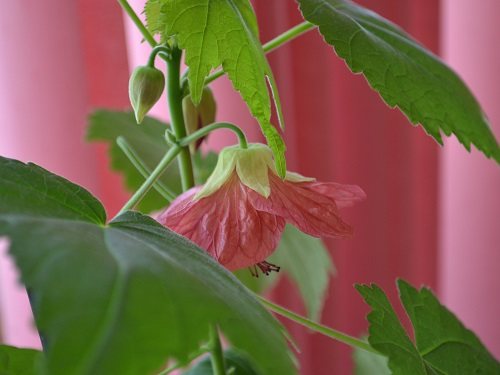

Abutilon: a description of a flower and how to buy seedlings
In this article you will find a description of the abutilon plant and recommendations on how to grow and propagate indoor maple at home.
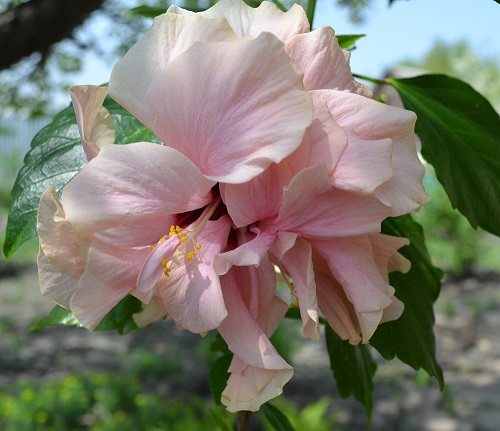

Hibiscus Classic Pink - description and sale
Rooted hibiscus stalk Classic Pink - 300 rubles. Blooming hibiscus seedling Classic Pink - 600 rubles.
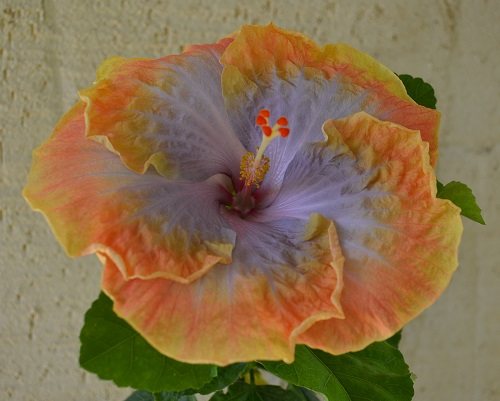

Buy Hibiscus Creole Lady
Rooted hibiscus stalk (depending on the variety) - from 300 to 500 rubles. Blooming hibiscus seedling - 600 rubles.
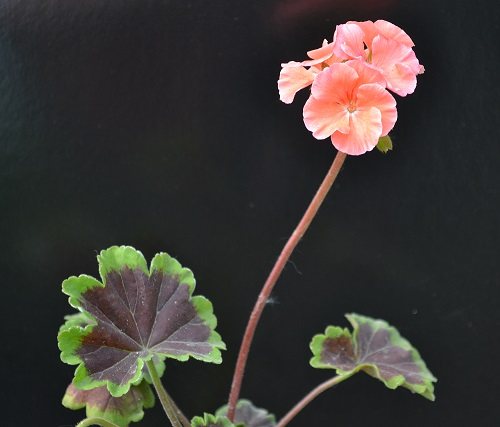

Geranium Black Barahat
You can buy a rooted stalk (300 rubles) or a flowering geranium plant "Black Velvet" (600 rubles) in our nursery.
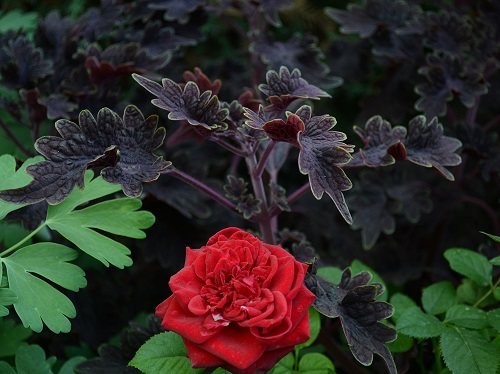

Coleus plant
Coleus is an ornamental perennial plant. Description of the Coleus flower and recommendations for care and cultivation. Buy coleus.
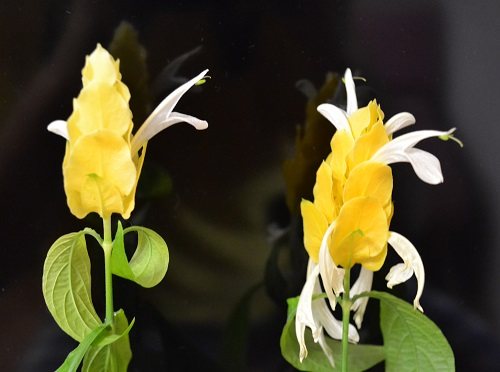

Pachistachis: reproduction and care
How to propagate pachistachis at home. Recommendations for growing and care. Sale of rooted pachistachis seedlings.
How to deal with the problem?
The first step is to try to rearrange the flower pot to another place and revise the watering schedule. If the reason for this state of the anthurium flower is leaf disease (how to treat and the photo is in the article), then it is necessary to identify them in time and prescribe the appropriate therapy. In case of chlorosis, the plant should be sprayed with iron chelate. Algae extract is also suitable. A distinctive feature of this disease is that the plant retains the normal color of the veins. Also, with chlorosis, anthurium must be provided with good lighting.
Flower diseases, treatment and prevention
Most often, anthurium diseases appear due to improper care, among which the greatest place is occupied by overflow and hypothermia, and as a result, decay of the root system.
Infectious diseases pose a great danger to the plant: anthracnose, fusarium, septoria, as a result of which the plant often dies even after treatment.
It is easier to deal with rust on leaves and various root rot. And almost all plants recover and improve their appearance if improper care was the cause of the disease.
Treatment of infectious diseases
Many infectious diseases lead to the death of the plant, but you still need to try to save the plant.
First of all, we isolate the damaged plant from the rest, examine it and make a preliminary diagnosis.
Always wear personal protective equipment when handling fungicides and do not eat or drink.
Fusarium wilting is an infectious disease in which the mycelium of the fungus penetrates into the living tissue of the plant and clogs up vital vessels. Root rot appears, passing into the trunk. Leaves that do not receive nutrition quickly wither and the plant dies. The best remedy is prevention. When planting, several grains of Trichodermin are introduced into the soil mixture, maintaining a high vitality of the plant. You can try to save the diseased anthurium by cutting off the living upper part and rooting it, having previously kept it in the Fundazol solution for 30 minutes.
Root rot is most often manifested when the plant is constantly overflowing. Treatment - pruning of rotten parts of the roots and treatment with Fitosporin-M or Maxim, transplanting into a new substrate and preferably a new pot.
Rust is a fungal disease that manifests itself on all parts of the anthurium, but most often on the leaves. For the purpose of prophylaxis at low temperatures and high air humidity, treatment with Fitosporin can be carried out, and with an already emerging disease - with Topaz, Ordan.
Powdery mildew appears when the temperature drops sharply with high humidity. Preventive measures - do not spray anthurium in cool weather (winter maintenance). Powdery mildew treatment - put the pot in a warm, dry place, spray with Topaz or Acrobat preparations.
Anthracnose appears due to high humidity, which is exactly what anthurium loves. The causative agents of the disease - fungi of the genus Colletotrichum and Kabatiella - may not manifest themselves for a long time, and when favorable conditions for them begin to infect the plant. Usually, the first symptoms appear on the leaves in the form of spots, which become more and more. The affected leaf shrinks, becomes thinner and looks like tissue paper. Further, anthracnose affects the stems and almost the entire plant dries up on the root. Anthracnose treatment should be started as early as possible. The first step is to remove all damaged leaves and destroy them. The soil is changed to a new one, and the roots of the anthurium are disinfected. The plant is quarantined with a decrease in air humidity and a reduction in watering. It is categorically impossible to spray, since the spores of the fungus are carried by droplets of water. If the plant is very sick, then fungicides are used: Baktofit, Fitosporin, Fundazol, Ridamin Gold, Silk. The plant is sprayed 2-3 times in 10-14 days.
Anthurium leaf disease photo how to treat?
A capricious foreigner from the tropics asks for content at a temperature not lower than +20 degrees and good lighting, while the sun's rays should not fall specifically on the flower. The plant feels great at the highest air humidity, therefore, it needs to be sprayed once a day (in warm weather, even 2 times a day). Watering is required in moderation, while the condition of the earth should be kept under control so that it is slightly damp.


Diseases
There are fungal, viral and non-infectious types of anthurium disease.
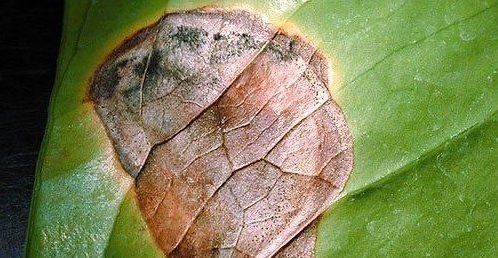

It is impossible to cure anthurium with folk remedies, you just miss the time, and it will die. Therefore, remove and destroy all affected parts of the plant. Spray the flower with any fungicide. The most effective drugs are Fitosporin-M, Alirin-B and Fundazol. The spraying procedure should be carried out outdoors or in a non-residential area. Place the pot with anthurium in a large plastic bag, treat it with a fungicide, close the bag tightly and leave it in this state for 15 - 20 minutes. Then open the bag, carefully take out the flower, let it dry and only then put it back. After 7 - 10 days, repeat the treatment.Observe the diseased plant - you may need a third treatment in a couple of weeks.
general information
Anthurium or, as the people say, "male happiness" is a tropical flower, thermophilic and gentle. The plant is very sensitive to external conditions, watering, feeding and other care. Having deviated from the correct agricultural technique, you can soon notice the flower's malaise.
If you see that the anthurium looks bad, weakens, the leaves turn yellow, suspicious spots appear on them, other alarming symptoms are observed, you should inspect the flower as soon as possible.
Having identified the problem, you need to tackle it. In most cases, it is enough to normalize the conditions of detention and pay more attention to care. However, sometimes anthurium gets sick quite seriously - then more effective measures have to be applied.
In total, there are three large factors that are the causes of anthurium disease:
- violation of agricultural practices and maintenance in unsuitable conditions;
- infectious diseases;
- damage by pests.
Each of these factors hides in itself many specific reasons that cause flower malaise in individual cases.
The appearance of dark spots on the peduncles of the anthurium flower
One of the diseases of indoor flowers, anthurium, is characterized by the formation of specks on the vellum of the peduncle. Although the plant loves to be sprayed with water, it does not tolerate when drops fall on the inflorescences. Affected flowers must be removed, and in the future such a violation in care should not be allowed.
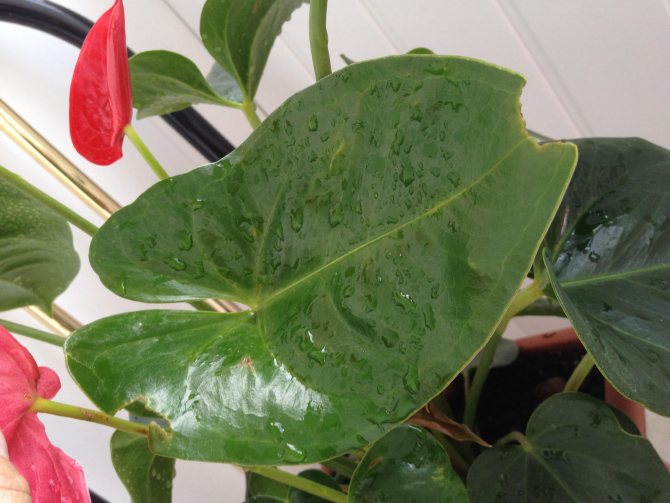

Sunburn
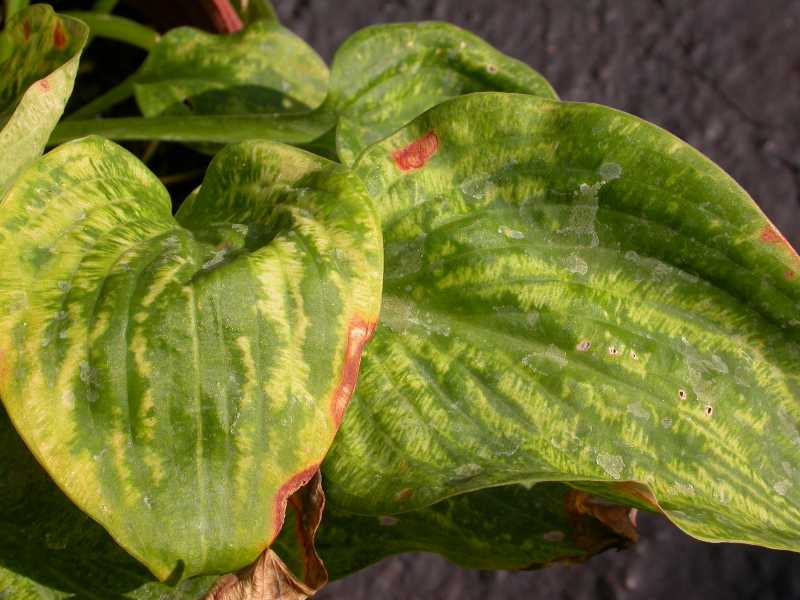

Yellowing of the leaves can also be associated with burns. In this case, brown and yellow spots are a characteristic symptom. Gradually, they begin to curl, dry up and fall off. In this case, the best treatment would be to rearrange the flower in a shaded area. Anthurium should not be left in a draft. It is also not recommended to use cold water for irrigation. In this case, the plant may freeze, from which small white specks will appear on the leaves. In such a situation, it is necessary to move the plant to a warmer place.

